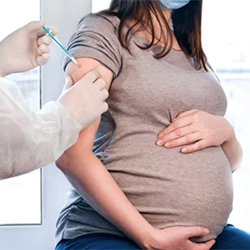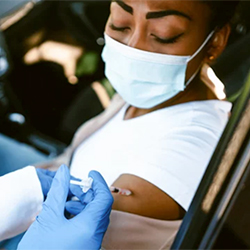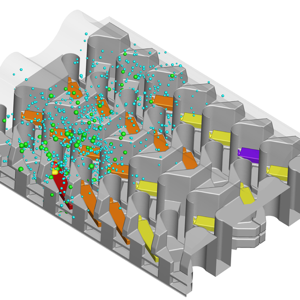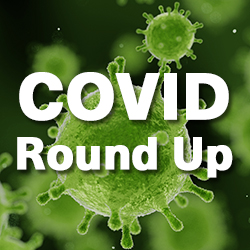By Marie Rosenthal, MS, and Ethan Covey
After a short hiatus, the COVID Roundup is back, featuring weekly news about, you guessed it, COVID-19. Vaccination, disease in children, mask-wearing and how SARS-CoV-2 is transmitted on an airplane are all part of this week’s roundup. A study of more than 40,000 pregnant women found no increased risk for preterm or small-for-gestational age births among women who were vaccinated. A survey found that although more Blacks were nervous about receiving a vaccine initially, they overcame their hesitance as they received more information. Pittsburgh researchers found that 44% of children hospitalized with COVID-19 or MIS-C suffered neurologic symptoms. People with asthma reported that the masks were uncomfortable, and they sometimes experienced shortness of breath, but in the end, realized it was important. “Just wear it,” they said. Our final report will not give a lot of comfort to people afraid of flying. A group looked at how SARS-CoV-2 was disbursed on two planes. Not comforting. One thing they found, though: Masks helped.
COVID-19 Vaccination Safe During Pregnancy
A large study of more than 40,000 pregnant women found no increased risk for preterm or small-for-gestational age (SGA) births among women who received COVID-19 vaccines (MMWR Morb Mortal Wkly Rep 2022;71[1]26-30).

“Many unvaccinated people who are pregnant have concerns about the vaccines,” said lead author Heather S. Lipkind, MD, an associate professor in the Section of Maternal Fetal Medicine, Department of Obstetrics, Gynecology and Reproductive Sciences, at Yale School of Medicine, in New Haven, Conn. “But getting infected with COVID-19 during pregnancy can result in severe disease. We now have the data to show that COVID-19 vaccines are safe for pregnant people, and COVID-19 infection is unsafe for pregnant people.”
The multisite, retrospective cohort study used data from eight Vaccine Safety Datalink healthcare organizations consisting of single-gestation pregnancies with estimated start or last menstrual period from May 17 through Oct. 24, 2020.
A total of 46,079 pregnant women with live births and available gestational age were included, 21.8% of whom received at least one COVID-19 vaccine dose during pregnancy. Of these women, 98.3% were vaccinated during the second or third trimester.
The study found that receipt of COVID-19 vaccination during pregnancy was not associated with preterm birth (adjusted hazard ratio [aHR], 0.91; 95% CI, 0.82-1.01). In addition, among the 40,627 live births with birth weight data, COVID-19 vaccination during pregnancy was not associated with SGA (aHR, 0.95; 95% CI, 0.87-1.03).
The study authors commented that risks remain for unvaccinated pregnant women and stressed that COVID-19 vaccination is the best way to protect against severe illness.
“The absolute risk for severe morbidity associated with COVID-19 in pregnancy is low,” Dr. Lipkind said. “However, women with symptomatic COVID-19 during pregnancy have a more than twofold increased risk for intensive care unit admission, invasive ventilation and extracorporeal membrane oxygenation, and a 70% increased risk for death, compared with nonpregnant women with symptomatic infections.”
To reduce COVID-19 risks, the CDC recommends vaccination for women who are pregnant and recently pregnant, including those who are lactating. The recommendation also applies to women who are trying to become pregnant now, or who might become pregnant in the future.
“In light of the spread of the highly contagious omicron variant, making it harder for expectant mothers to avoid the virus through means other than vaccination, these findings should be reassuring to pregnant women,” Dr. Lipkind said.
Blacks Overcame Vaccine Hesitancy Faster Than Whites
Black Americans who were initially hesitant about receiving a COVID-19 vaccine were more likely than whites to warm up to the idea as the pandemic wore on and to view vaccines as necessary for protection, a new study found (JAMA Network Open 2022 Jan 21. doi:10.1001/jamanetworkopen.2021.44470).

The research highlights the importance of not making assumptions about race-based viewpoints regarding healthcare, and illustrates the likelihood that access—not just distrust or skepticism—is a significant obstacle to higher levels of COVID-19 protection among Blacks, the study authors said.
“From the start of the vaccine rollout, we began to hear about how Black Americans were going to resist vaccinations. Our study highlights that any emphasis on hesitance as the primary challenge to vaccination among Black Americans would be a mistake,” said study lead author Tasleem Padamsee, PhD, of the Ohio State University College of Public Health, in Columbus.
“We must not lose sight of the significant access barriers that persist, including distant vaccine sites, lack of transportation and inflexible work hours.”
The study followed the same group of Americans over time, surveying them about their views regarding the pandemic. This approach allowed the researchers to measure how individual and group perspectives shifted during a time when the world was gaining new information about both the virus and the vaccine daily.
Data were collected in seven waves from an initial group of 1,200 participants. (Response numbers decreased modestly as the study progressed.) The surveys began before vaccines became available in late 2020, and ended in June 2021. Participants were asked about their likelihood of getting a vaccine as well as beliefs regarding the safety, efficacy and need for the vaccine.
About 38% of Black participants and 28% of white participants were hesitant at the start of the study. By June, 26% of Blacks and 27% of whites were hesitant. “The data suggest that Black communities were particularly focused on ways to protect themselves and their communities as more evidence emerged that vaccines were effective and safe,” said study co-author Kelly Garrett, PhD, a professor of communication at Ohio State.
COVID-19 has disproportionately affected Black Americans, who’ve experienced inequitable rates of illness and death and worse economic impacts. The vaccination rate for Black Americans continues to lag behind the rate for white Americans.
“While Black Americans’ intention to get vaccinated has gone up, their actual vaccination rates haven’t gone up as quickly. That suggests that there are other obstacles to vaccination. We have good reason to think that has to do with access, something we must continue to work on,” Garrett said.
Dr. Padamsee added: “I expected that the same qualities that lead Black communities to be cautious about a new vaccine would lead them to accept the vaccine once they gathered more information. The unifying theme is protection. Black Americans want to protect themselves and their communities,” she said.
The National Science Foundation supported the study.
44% of Hospitalized Kids With COVID-19 Symptoms Developed Neurologic Symptoms
Forty-four percent of hospitalized children diagnosed with COVID-19 or multisystem inflammatory syndrome in children (MIS-C) developed neurologic symptoms, according to a new study from the University of Pittsburgh School of Medicine (Pediatr Neurol 2022;128:33-44).
These children were more likely to require intensive care than their peers who didn’t experience COVID-19 symptoms. These preliminary findings are the first insights from the pediatric arm of GCS-NeuroCOVID, an international multicenter consortium aiming to understand how COVID-19 affects the brain and central nervous system.

“One of the consortium’s big questions was whether neurological manifestations are similar or different in pediatric patients, depending on which of these two conditions they have,” said lead author Ericka Fink, MD, a pediatric intensivist at UPMC Children’s Hospital of Pittsburgh, and an associate professor of critical care medicine and pediatrics at the University of Pittsburgh.
To answer this question, the researchers recruited 30 pediatric critical care centers globally. Of 1,493 hospitalized children, 1,278 (86%) were diagnosed with acute SARS-CoV-2; 215 (14%) were diagnosed with MIS-C, which typically appears several weeks after clearing the virus and is characterized by fever, inflammation and organ dysfunction.
The most common neurologic manifestations linked with acute COVID-19 were headache, acute encephalopathy and seizures, while youths with MIS-C most often had headache, acute encephalopathy and dizziness. Rarer symptoms of both conditions included loss of smell, vision impairment, stroke and psychosis.
“Thankfully, mortality rates in children are low for both acute SARS-CoV-2 and MIS-C,” Dr. Fink said. “But this study shows that the frequency of neurological manifestations is high, and it may actually be higher than what we found because these symptoms are not always documented in the medical record or assessable. For example, we can’t know if a baby is having a headache.”
The neurologic manifestations were more common in children with MIS-C than those with acute SARS-CoV-2, and MIS-C patients were more likely than those with acute illness to have two or more neurologic manifestations.
According to Dr. Fink, the team recently launched a follow-up study to determine whether acute SARS-CoV-2 and MIS-C—with or without neurologic manifestations—have lasting effects on children’s health and quality of life after discharge from the hospital.
“Another long-term goal of this study is to build a database that tracks neurological manifestations over time—not just for SARS-CoV-2 but for other types of infections as well,” she added. “Some countries have excellent databases that allow them to easily track and compare children who are hospitalized, but we don’t have such a resource in the U.S.”
This study was partly funded by the Neurocritical Care Society Investing in Clinical Neurocritical Care Research (INCLINE) grant.
New Study Reports Mask-Wearing Experiences of Adults With Asthma
Even though people with asthma reported that they almost uniformly adhered to mask-wearing in public, 84% experienced discomfort, and 75% reported trouble breathing or shortness of breath at least a little of the time while wearing a mask, according to a new online survey.
Researchers at the University of Illinois Chicago conducted an online survey of 501 adults with asthma to better understand the extent of, and the problems related to, mask use during the pandemic (J Allergy Clin Immunol 2022;10[1]:116-123).
The study team found an association between poorer asthma control and more symptoms while wearing a mask (Mask Effects Scale [MES]). This finding is likely due to the fact that those with uncontrolled asthma are more likely to experience shortness of breath and trouble breathing even without a mask, according to Sharmilee Nyenhuis, MD, an associate professor at the university.
The researchers also found that the longer a person wears a mask, the more likely they are to have a higher MES score.
In addition to answering survey questions, participants were asked open-ended questions about their experiences wearing masks, as well as their recommendations for others with asthma.
When asked to comment on their experiences wearing a mask, 45% indicated they had problems breathing and increased coughing. However, 39% indicated they had no change in their asthma when wearing a mask. Of note, 5% responded they did not always wear a mask, and 2% indicated they had improved asthma/asthma symptoms when wearing a mask, likely because the mask protected them against pollen/pollutants that triggered their asthma, according to the study.
Despite discomfort, most of the participants noted the importance of wearing masks. “The majority of those surveyed said about masks, ‘Just wear it,’” Dr. Nyenhuis said.
Other survey participant suggestions include:
- Take the time to find a comfortable, well-fitting mask. “Wear cotton masks as they are lightweight and more moisture-wicking than synthetic materials.” “Surgical masks feel better than cloth masks, easier to breathe.”
- Keep an inhaler with you. “Stay on top of your meds.”
- Take a mask break and use breathing techniques. “Stay calm, and take frequent breaks in circumstances where you can take your mask off for a few minutes.” “Make appropriate ADA [Americans with Disabilities Act] accommodations with your employer for scheduled mask-off breaks.”
- “Taking a mask break is important. It allows for opportunities to take large, deep breaths and do some breathing techniques,” Dr. Nyenhuis said. Employers should consider making accommodations for those with asthma to take safe mask breaks.
Other suggestions from the survey participants include using a pulse oximeter to show yourself you are getting enough oxygen when wearing a mask; make sure your mask is room temperature if cold triggers your asthma; apologize to others around you if you must cough and verbalize you have asthma; and stay home as much as possible.
Dr. Nyenhuis said there is no reason a person with asthma should not wear a mask, but those who have concerns about wearing a mask should contact their physician.
Fear of Flying?
Afraid of flying? New study results about SARS-CoV-2 transmission might not put your mind at ease. Researchers found that SARS-CoV-2 droplets were easily dispersed throughout the cabin, according to a simulation study (Indoor Air 2022 Jan 19. doi:10.1111/ina.12979 https://onlinelibrary.wiley.com/doi/full/10.1111/ina.12979).
The researchers simulated the transmission of SARS-CoV-2 on a flight from London to Hanoi, Vietnam, and on another flight from Singapore to Hangzhou, China. The first flight was almost 12 hours long; one of 21 passengers in business class was positive for COVID-19; and by the end of the flight, 12 passengers in business class were infected. The Singapore to Hangzhou flight was five hours and 30 minutes long. Although 16 patients on the plane were diagnosed with COVID-19, most were infected before boarding the plane, the researchers said. Only one passenger was infected during the flight.
 This graphic demonstrates transmission on a flight. Image from Dayi Lai, PhD
This graphic demonstrates transmission on a flight. Image from Dayi Lai, PhD
The researchers simulated how the droplets could have spread around the cabin. They found droplets of different sizes generated by coughing, talking and breathing in an airline cabin by an infected person traveled easily throughout the air and could be inhaled by other passengers.
The scientists counted the number of viral copies that would have been inhaled by each passenger to determine infection, and were able to predict 84% of both the infected and uninfected cases on the first flight.
The team also found that wearing masks and reducing conversation frequency between passengers could help to reduce the risk for exposure on the second flight.
“It’s important to know that wearing masks makes a significant impact on reducing the transmission,” said corresponding author Dayi Lai, PhD, an associate professor and associate head of the Department of Architecture, School of Design of Shanghai Jiao Tong University, in China.


